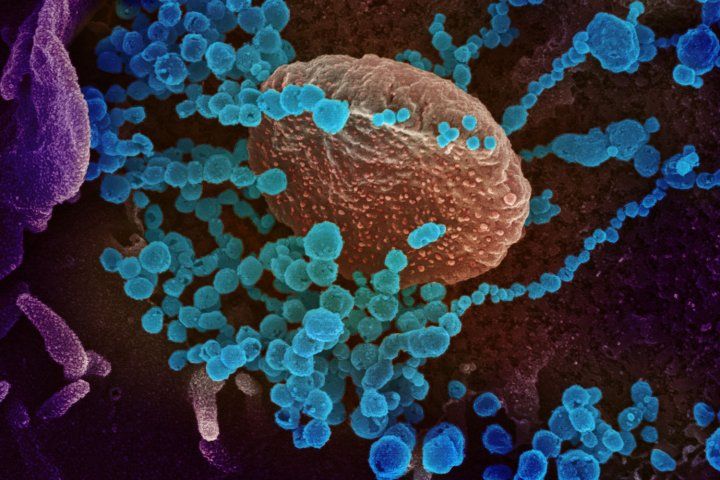As Coronavirus Spreads, Experts Explain When to Call a Doctor, How Testing Works and More

Scanning electron microscope image of the new coronavirus, SARS-CoV-2 (blue), emerging from the surface of cells cultured in the lab. Image credit: NIAID-RML
Editor’s Note: This story was updated on Mar. 13 to reflect the latest CDC recommendations for when to seek medical advice.
As COVID-19, the disease caused by the novel coronavirus, continues to spread around the world, the U.S. Centers for Disease Control and Prevention has advised organizations to prepare for possible community transmission in the United States.
As concerns about the outbreak begin hitting closer to home, UC San Francisco infectious disease experts are providing the latest updates on what the public needs to know.
Deborah Yokoe, MD, MPH, medical director for hospital epidemiology and infection prevention at UCSF Health, and Robert Kosnik, MD, director of the UCSF Occupational Health Services, addressed some common concerns about the new coronavirus.
How do I protect myself and my family against the new coronavirus?
“The best way to protect yourself and your family from COVID-19 is to follow all the same basic practices that are important for protecting yourselves from influenza,” said Yokoe.
According to the U.S. Centers for Disease Control and Prevention (CDC), these include
- Washing hands often with soap and water for at least 20 seconds
- If soap and water are not available, using an alcohol-based hand sanitizer with at least 60 percent alcohol
- Avoiding close contact with people who are sick
- Avoiding touching your eyes, nose, and mouth
- Covering your cough or sneeze with a tissue, then throwing the tissue in the trash, and washing your hands
- Cleaning and disinfecting frequently touched objects and surfaces
- Staying home when you are sick
What are the symptoms of COVID-19? Is it possible to distinguish from a cold or flu?
The symptoms of COVID-19 infections can range from very mild to severe respiratory illness and may include fever, cough and shortness of breath. These symptoms can be very similar to those for influenza, so it may be difficult to distinguish without clinical testing.
“We are still learning more about COVID-19 every day,” said Yokoe, “But based on the most comprehensive information that we have so far from China, about 80 percent of COVID-19 infections were thought to be mild infections and a small proportion of people developed severe pneumonia.”
When should I seek medical attention if I’m worried about the coronavirus? What’s the best way to do that?
According to the CDC, if you think you have been exposed to COVID-19 and develop a fever and symptoms such as cough or difficulty breathing, call your doctor’s office, urgent care clinic, or emergency department for medical advice. This will help your health care provider to take steps to keep other people from getting infected if you need to come in.
In the meantime, if you feel sick, it’s a good idea to wear a facemask, avoid public areas, and stay away from others in your home.
If you have a medical emergency, call 911 and notify the dispatch personnel that you have or are being evaluated for COVID-19.
Should I start wearing a mask when I’m at work or out in public? If not now, when might that change?
The CDC and other public health experts do not recommend that people who are well wear face masks as a way to protect themselves from respiratory illnesses, including COVID-19.
As there is currently a limited global supply of masks, they should be reserved for caregivers of patients with infections that require mask use or by patients with cough or other symptoms of respiratory illness.
“In hospitals like the UCSF Medical Center,” said Yokoe, “we do ask patients who are sick with respiratory illnesses to wear a mask as a way to contain the respiratory droplets that are produced when they cough or sneeze in order to prevent spreading infections to others.”
Kosnik explained that masks are more effective when worn by someone who is sick to prevent respiratory droplets from escaping – so if you are sick, it may be a public service to wear a mask if you need to be out and about.
“If there were widespread community transmission, like the kind in some parts of China, then there may be some advantage to wearing a mask out in public – but we’re a long ways away from that here,” said Kosnik.
If I don’t have health insurance, can I still get care?
“Anyone who requires medical care can receive care, regardless of insurance status,” said Yokoe.
What are the testing criteria for COVID-19 now that there are cases of community transmission with no travel history?
Decisions about testing currently are made on a case-by-case basis by health care providers and public health departments. The CDC testing criteria for COVID-19 were recently expanded to include a wider group of symptomatic patients after more cases of community transmission were confirmed in the U.S.
The CDC’s persons under investigations (PUI) criteria, which offer guidance on who to test for COVID-19, were last updated on March 4, 2020:
- Clinicians should make decisions on whether a patient should be tested based on the patient’s signs and symptoms as well as the local epidemiology of COVID-19.
- The CDC notes that most patients with confirmed COVID-19 have developed fever and/or symptoms of acute respiratory illness, such as cough or difficulty breathing.
- Clinicians are strongly encouraged to test for other causes of respiratory illness, such as the flu.
Whereas initially, most diagnostic testing had to be performed at the CDC in Atlanta, Yokoe said there is ongoing work to increase the capacity for testing on the state and local level, as well as research to develop new rapid diagnostics. In California, there is increasing access to testing at public health laboratories that have received CDC test kits. Other clinical laboratories may perform diagnostic tests authorized by the FDA under an Emergency Use Authorization.
How are hospitals preparing for COVID-19?
Hospitals, including UCSF Medical Center, are working hard to handle the spread of COVID-19 in the U.S., which includes creating plans for outpatient clinics, emergency departments, and inpatient settings so they are flexible enough to care for larger numbers of patients with COVID-19.
“At UCSF Health, we have activated our emergency command centers and are meeting several times daily to stay on top of the situation,” said Yokoe. “We are working closely with the San Francisco, Alameda County, and California Departments of Public; the CDC; and other area hospitals.”
“We are ensuring that all CDC recommendations for caring for patients with COVID-19 are in place, such as being able to put these patients into the right type of hospital rooms, making sure that appropriate personal protective equipment (such as respiratory protection, gowns, and gloves) are available, and that staff who will be caring for these patients are able to use that equipment correctly.”
San Francisco Mayor London Breed declared a public health emergency on Feb. 25, 2020, to enable the city to mobilize resources, accelerate emergency planning, streamline staffing, coordinate agencies and allow for future reimbursement by state and federal agencies, if the need arises.
If UCSF Health is treating COVID-19 patients, will other patients be safe in the hospital?
UCSF Health cares for patients with some of the most complex health conditions and is highly experienced in infection prevention and control. Its infection prevention practices and protocols are aimed at ensuring that faculty, employees and contractors, as well as other patients and visitors remain safe in the hospital.
UCSF Health has put into the place CDC-recommended infection prevention protocols and procedures to prevent spread of infection from patients with COVID-19, said Yokoe.
These include placing patients with confirmed or possible COVID-19 infection into isolation rooms with negative pressure and special ventilation to prevent the spread of illness to other patients and staff. UCSF Health has over 40 airborne infection isolation rooms and can adapt additional rooms to care for larger number of patients, if needed.

UCSF Coronavirus Resources
Information for the UCSF community, including procedures, guidance for travelers, and latest updates.